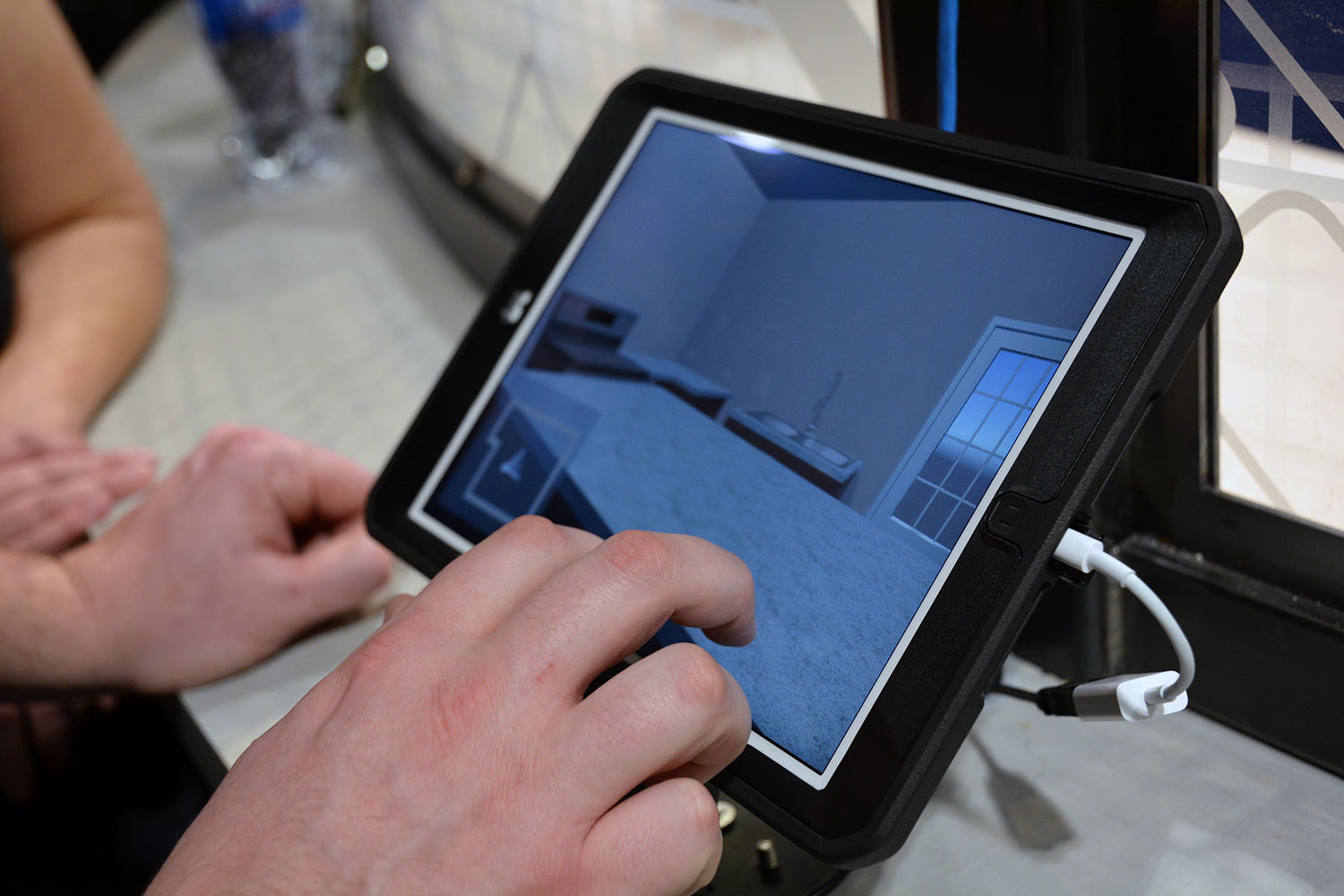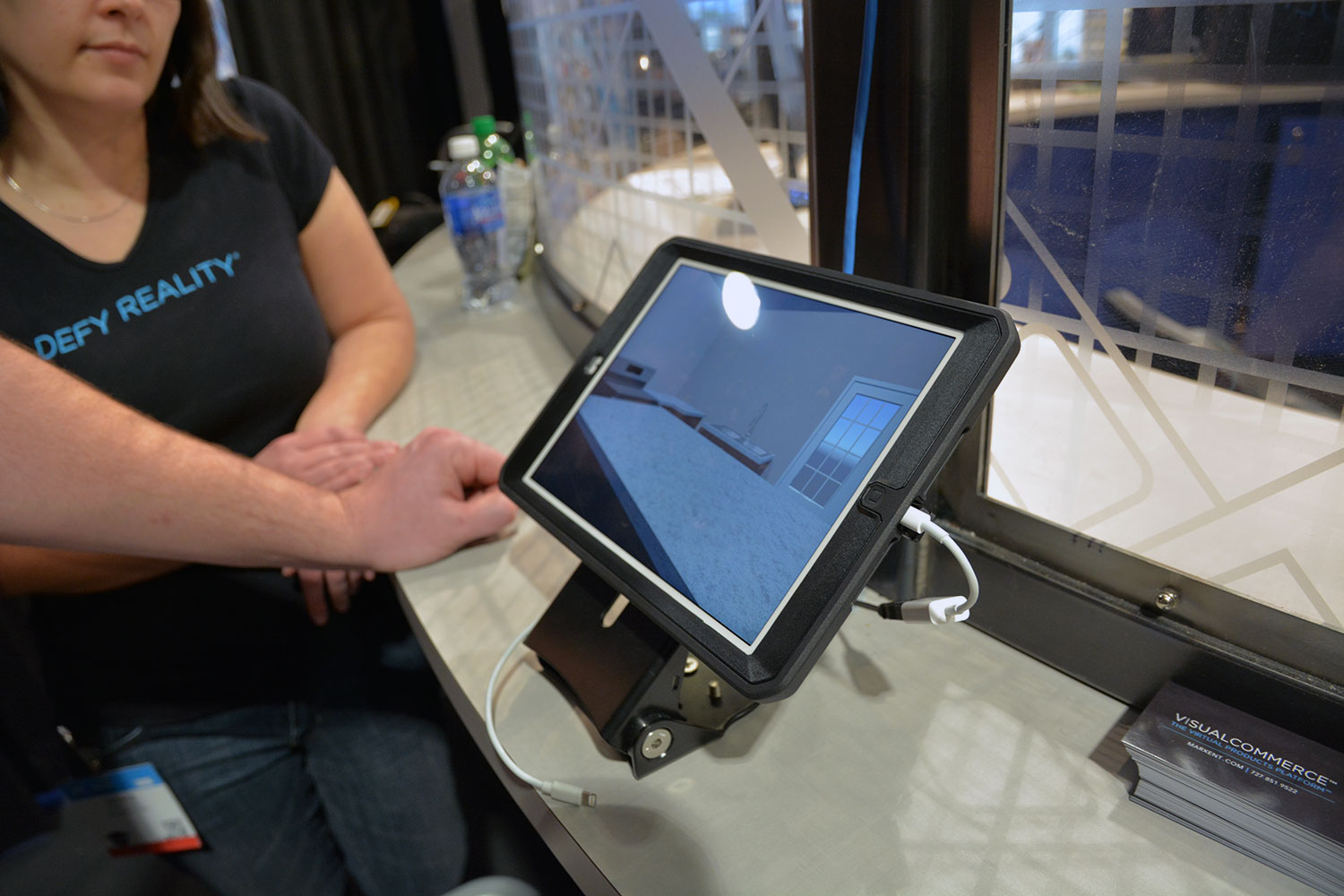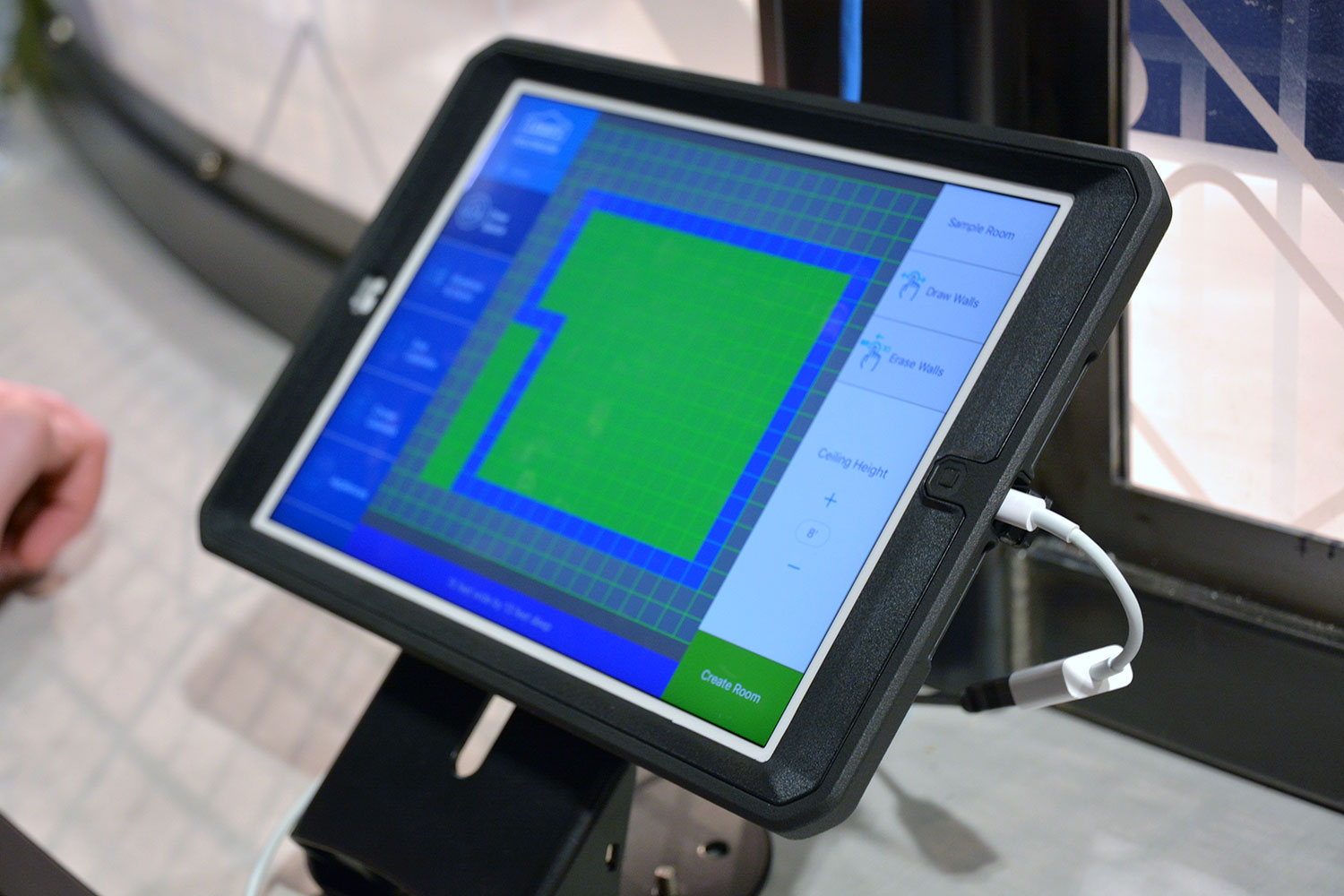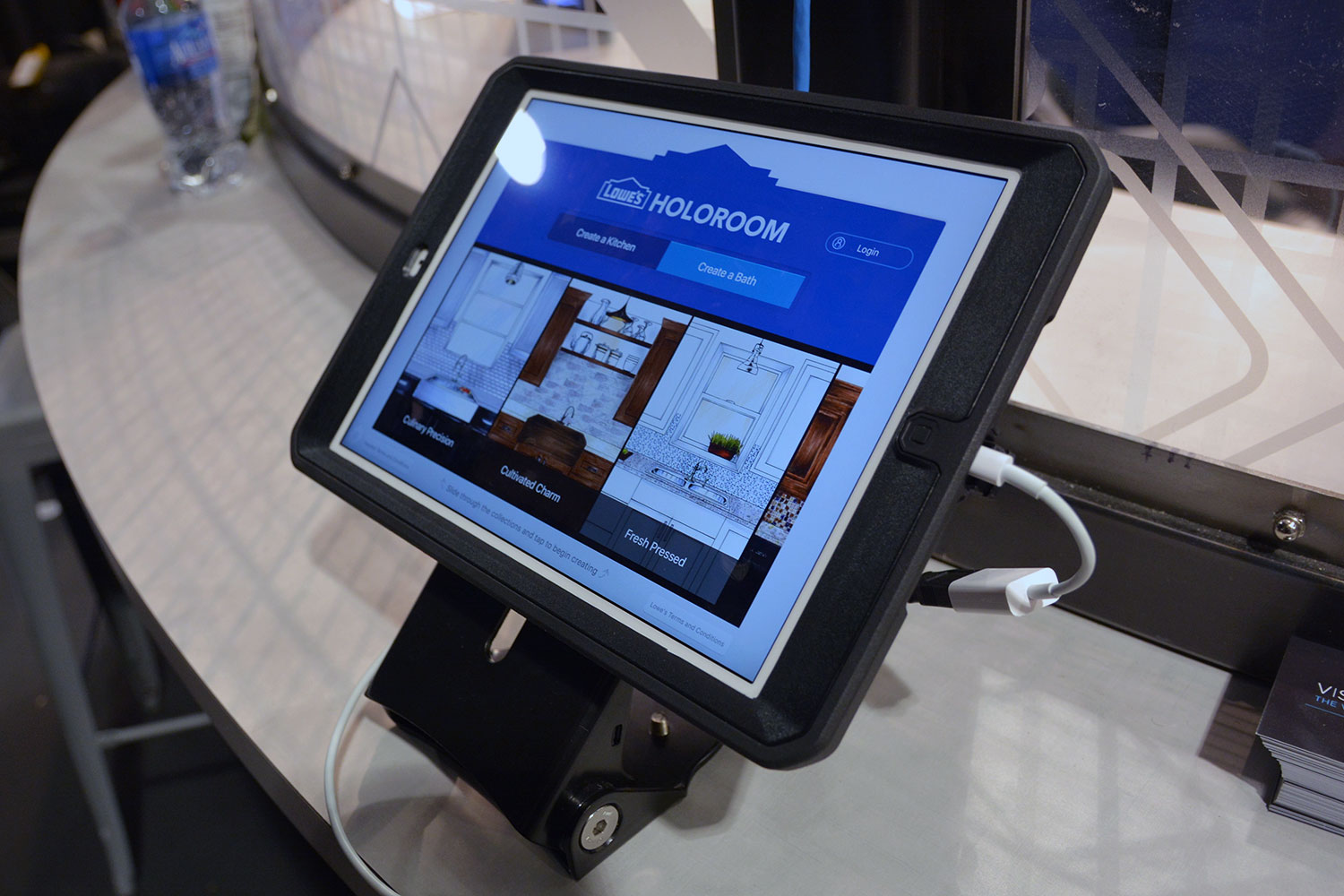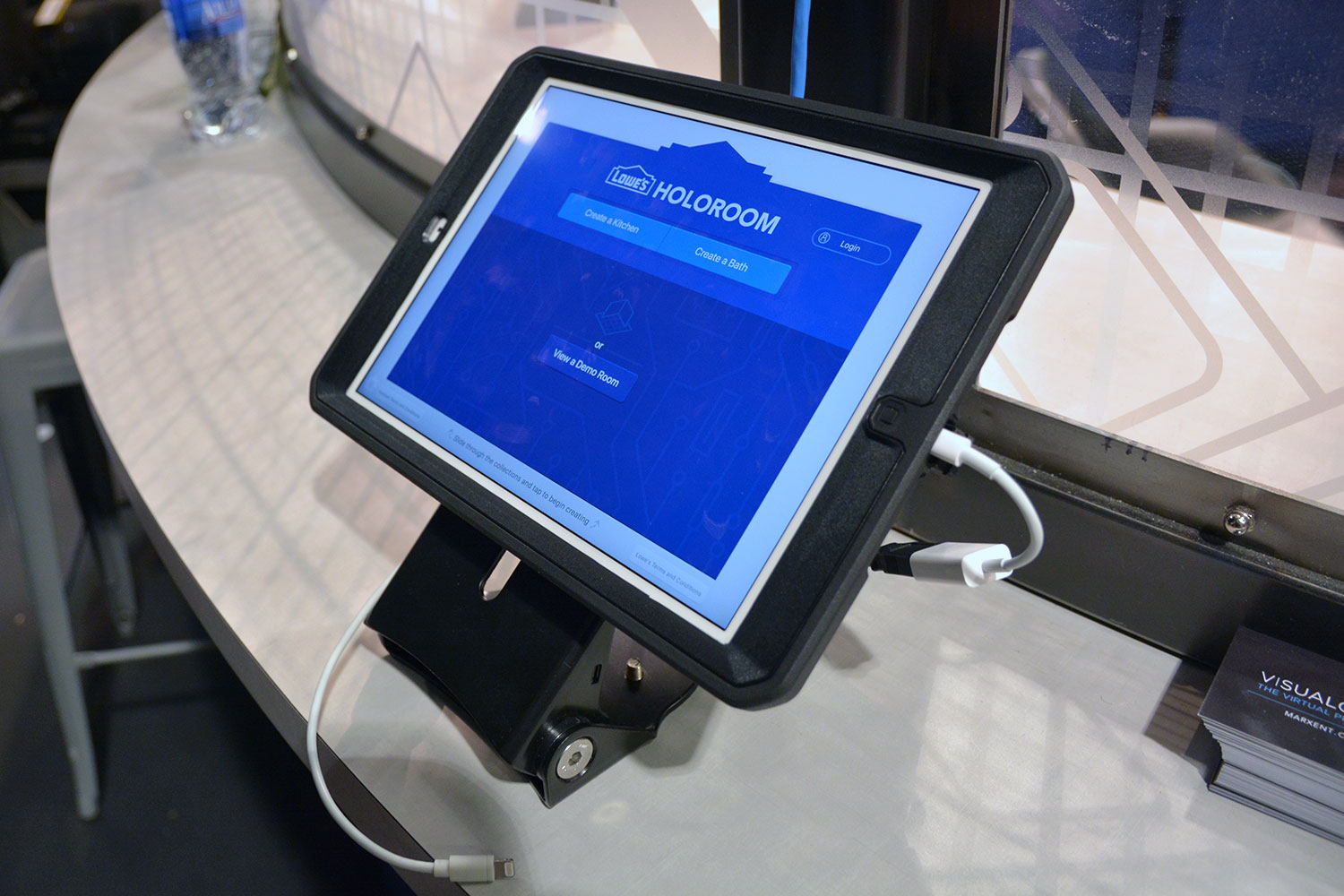You’re about to spend $37,000 on a custom kitchen. Do you want eco-conscious bamboo flooring or Corinthian tile? Stonebriar or garden sage paint for the walls? Will the long neck on that commercial sink fit underneath your cabinets?
Unless you have a supernaturally vivid imagination, you won’t really know the perfect choices until a contractor drives the last screw into place. And by then, it’s too late. That’s exactly why virtual and augmented reality are taking over this year’s International Builder’s Show in Las Vegas.
Seeing the unseen
Virtual reality consistently wows just about anyone willing to wear a headset, but if critics have one enduring and legitimate complaint, it’s this: What’s it good for?
Video games, sure. And definitely porn. But homebuilders at IBS have a more productive answer: It can show you the future while you still have time to shape it.
Contractors can use an iPad to show you a new deck where crabgrass currently reigns.
“The home improvement space is a fantastic place for AR and VR to take off,” Marxent Labs CEO Beck Besecker told Digital Trends. His company’s VisualCommerce platform can build VR applications to sell absolutely anything, but right now, the people flocking to it are builders — the same guys who might proclaim the superiority of hand planes built before your grandfather was born.
Azek and TimberTech use AR to show customers the dream decks they can build with their composite decking materials. Toss a special mat behind your house and contractors can use an iPad to show you a gorgeous new deck where crabgrass and dandelions currently reign.
At a demonstration in Marxent’s booth, we laid the mat on a patch of carpet and watched a deck spring up in its place on an iPad. First it was just a railing, then boards appeared one at a time as I tapped a button to add them. Clicking a magnifying glass, I could change their color or swap up the bannisters. It all happened in real time, as life carried on around my virtual deck on the show floor.
“You can see your project from all angles,” says Julia Fitzgerald, Chief Marketing Officer for brands Azek and TimberTech, which share the same parent company. “You can see it from the backdoor window of your nosy neighbor’s house.”
KBIS 2016: Frigidaire’s Cool Connect smart A/C lets you cool on demand
The Lowe’s Holoroom, which Marxent also developed and we named a finalist at the 2015 CES, gives an even more immersive experience, using VR (virtual reality) instead of merely AR (augmented reality). Stop by one of the few pilot locations in Colorado or Ohio that offer it and you can literally draw a room from scratch on an iPad, equip it with more than 4,000 Lowe’s items, then put on an Oculus Rift headset and inhabit that room before you ever so much as lift a paint brush.
“You can see your project from the window of your nosy neighbor’s house.”
Should the fridge go in the corner or next to the sink? Will a dark blue make your room feel smaller? Does stainless steel fit with these marble countertops? The Holoroom lets you try it in VR, change it, and keep fiddling until you’re happy.
An upcoming home version, due out in February, will let you and your spouse squabble over cabinet choices in the comfort of your own (presumably dated) living room, then come to Lowe’s when it’s time to dive in and check it out what it could look like.
Happily for Lowe’s, either way you can also walk out with a list of the stuff you need to buy to make it reality.
The home of your dreams
Remodeling is just scratching the drywall of what VR can do for your home. If changing the appliances and surfaces in a kitchen seems daunting, imagine building an entire dream home from scratch.
A Canadian company called Cadsoft is already doing that with an upcoming version of its Envisioneer software. Envisioneer is what builders call building information modeling (BIM) software. It will show you not only what your soon-to-be abode will look like but also how many two-by-fours, screws, and nails you’ll need to put it together — and what it will cost.
The 12th version, due out this summer, will let you explore in virtual reality before sawing a single board.
At the Envisioneer booth, I donned a late-model Oculus Rift and explored a modern lot complete with granite countertops, an antique gas pump, and a hanging motorcycle. It felt like I was there.
I could lean in and inspect the countertops, walk behind the kitchen island and see if it felt tight, and peek under the bed like some kind of nosy creep in my virtual future house.
Yes, moving around with a PlayStation-like controller made me ready to yack when I raced around the floor a bit too fast, but the same nitpicks that would make this unplayable as a game don’t matter in the homebuilding realm. You can excuse some rough edges for the value of the takeaway.
Go for a tour
Even homebuilders who’ve already invested in real, tangible model homes have found a use for VR: Saving you the trip. GoTour is an app that lets you tour model homes from the comfort of your iPad in vivid detail. Right now, you can “walk” around a model home the same way you would navigate Google Street View, but in six months, you’ll be able to do the same thing in VR with a headset.
I could peek under the bed like some kind of nosy creep in my virtual future house.
I tried the beta experience on a Samsung Gear VR, and the level of immersion is astonishing. Although your viewpoint is fixed, the worlds have real depth. Looking at a series of blue orbs scattered around the home lets you effortlessly navigate up around, and a smooth transition between viewpoints makes it feel more like you’re walking than being teleported.
These aren’t just panoramas. “We’re using a specialized scanner, it’s actually a three-dimensional scan of the house,” explains CEO Paul Cardis. “You couldn’t do that with pictures. There’s actually an infrared scan of each of these rooms, that’s then pieced together with a computer, and that allows us to be in each one of those spaces.”
Seeing is believing
There’s one glaringly obvious reason VR and AR have already become legitimate tools to homebuilders yet remain toys to other industries: Construction ain’t cheap.
“These are pretty ‘high-consideration’ purchases,” points out Besecker. “These can be $30,000, $40,000, $50,000 purchases.”
You would never buy a $50,000 car without a test drive, yet when it comes to remodeling, people do it all the time. Build it and you’ll find out — then pay another $10,000 to fix it when it’s not quite what you expected. With those kind of stakes, a contractor can easily spend the four digits required for VR hardware without flinching.
KBIS 2016: The view from Las Vegas’ prestigious luxury condos? The tech of the future today
Which brings us to the other reason VR is flourishing in home improvement, perhaps just as obvious: There’s just no good alternative. Almost every other purchase experience offers some way to sample the wares, whether it’s walking around a store in a pair of $400 boots or kicking back at Best Buy in front of a $4,000 TV. Home improvement projects offer nothing as visceral, save for a blueprint and your imagination.
Maybe that’s why clothing retailers have toyed with using AR to plaster virtual clothes onto you as you stand in a mirror, saving you that irritating trip to the dressing room, but it has never really caught on. It’s hard to compare trying on jeans in a glorified closet with gutting your bathroom to the studs and building it up from scratch.
“This is the very first major application of VR in the world – the home improvement industry,” says Bedecker proudly. Gamers might dispute that. But if the halls of the International Builder’s Show, where the Oculus Rift is no stranger, are any indication, he’s not the only one with the inkling.
VR may have finally found its home: At home.
